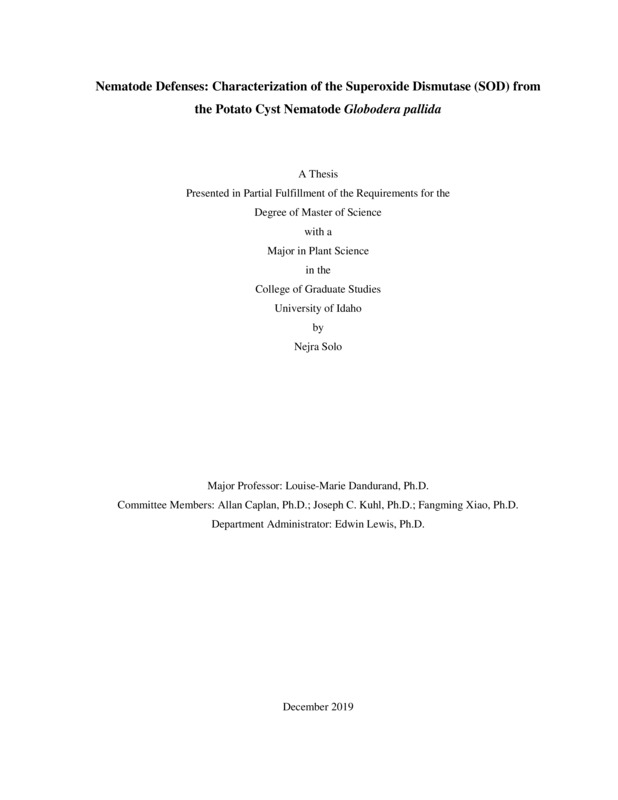Nematode Defenses: Characterization of the Superoxide Dismutase (SOD) from the Potato Cyst Nematode Globodera pallida
Solo, Nejra. (2019-12). Nematode Defenses: Characterization of the Superoxide Dismutase (SOD) from the Potato Cyst Nematode Globodera pallida. Theses and Dissertations Collection, University of Idaho Library Digital Collections. https://www.lib.uidaho.edu/digital/etd/items/solo_idaho_0089n_11745.html
- Title:
- Nematode Defenses: Characterization of the Superoxide Dismutase (SOD) from the Potato Cyst Nematode Globodera pallida
- Author:
- Solo, Nejra
- ORCID:
- https://orcid.org/0000-0002-5531-5929
- Date:
- 2019-12
- Keywords:
- Globodera pallida litchi tomato PCN Solanum sisymbriifolium superoxide dismutase
- Program:
- Plant, Soil and Entomological Sciences
- Subject Category:
- Plant pathology
- Abstract:
-
Potato cyst nematodes (PCN), such as Globodera pallida and Globodera rostochiensis, are some of the most agriculturally and economically important pests of potato. If no measures are used to control this pathogen, then it has the potential to cause up to 80% yield loss. Globodera pallida is a sedentary endoparasitic nematode that infects the roots of a susceptible plant in order to establish a feeding site as a sole source of nutrition for its development. Plants are not defenseless when exposed to pathogens and are able to fight off most of them by activating an innate immune system. An oxidative burst, along with the production of the reactive oxygen species (ROS), is an important part of plant defenses. Reactive oxygen species, such as superoxide radical (O2-˙), hydrogen peroxide (H2O2), and hydroxyl radical (OH·) are highly toxic molecules that cause damage to pathogens. In order to successfully infect the plant, nematodes protect themselves from ROS through the activation of antioxidant metabolism and ROS scavenging enzymes. One of these enzymes is a superoxide dismutase (SOD; EC 1.15.1.1), which prevents cellular damage by catalyzing conversion of the superoxide radical (O2-˙) to hydrogen peroxide (H2O2) and molecular oxygen (O2). The main goals of this study were to: 1) isolate and localize the expression of the SOD gene from G. pallida, and 2) study its expression after infection of the susceptible potato cv. Desiree, resistant potato cv. Innovator, and immune host (Solanum sisymbriifolium). We have isolated a putatively secreted isoform of the superoxide dismutase from G. pallida and localized the expression of this gene in the posterior region of the nematode, to the hypodermal tissue. However further analysis is required to determine if this enzyme is being secreted to the surface of the nematode. The SOD gene was significantly upregulated when nematodes infected roots of a host plant, but significant differences in expression during the infection of susceptible, resistant, or immune hosts were not observed. Our study suggests that this gene may be responding to stress regardless of whether the nematode is experiencing a compatible or an incompatible interaction.
- Description:
- masters, M.S., Plant, Soil and Entomological Sciences -- University of Idaho - College of Graduate Studies, 2019-12
- Major Professor:
- Dandurand, Louise-Marie
- Committee:
- Caplan, Allan ; Kuhl, Joseph C; Xiao, Fangming
- Defense Date:
- 2019-12
- Identifier:
- Solo_idaho_0089N_11745
- Type:
- Text
- Format Original:
- Format:
- application/pdf
- Rights:
- In Copyright - Educational Use Permitted. For more information, please contact University of Idaho Library Special Collections and Archives Department at libspec@uidaho.edu.
- Standardized Rights:
- http://rightsstatements.org/vocab/InC-EDU/1.0/

